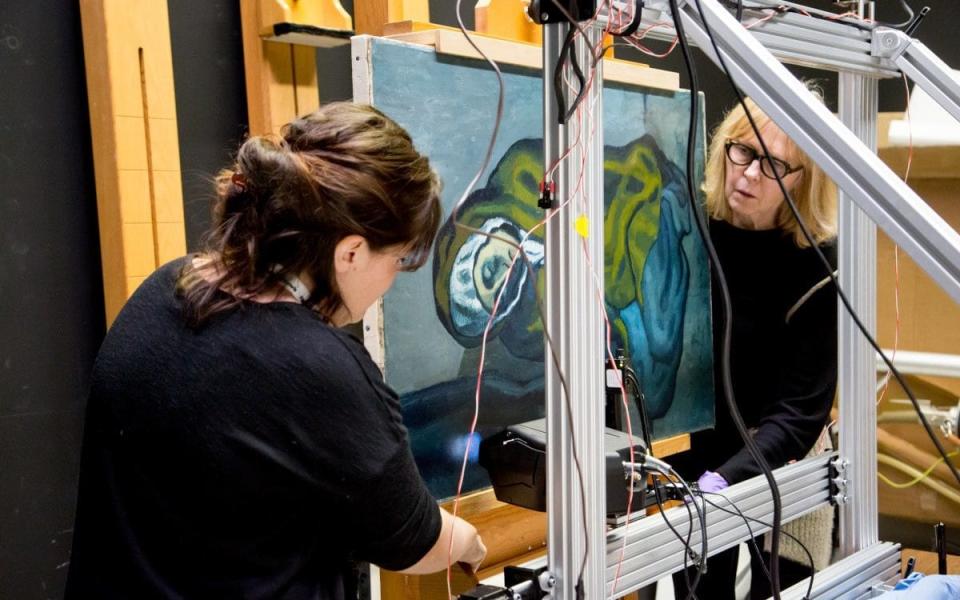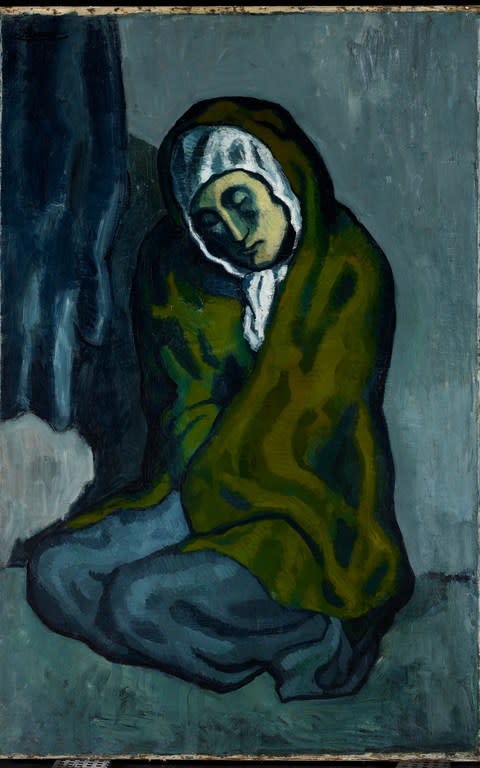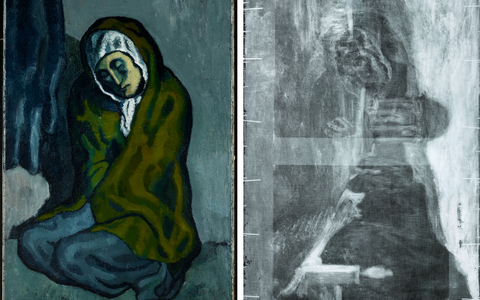X-rays reveal secret side to Picasso's blue period masterpiece

At first glance the undulating lines of Pablo Picasso’s La Miséreuse accroupie (The Crouching Woman) appear to have been meticulously placed to hint at a shoulder, waist and hip beneath the beggar’s green cloak.
But new scans of the Blue Period masterpiece suggest that the Spanish artist actually traced the contours of her back from an image of Barcelona on the canvas beneath.
X-rays have revealed an entirely different scene below Picasso’s work, which experts think was a painting of the Parc del Labertint d’Horta, a formal garden on the outskirts of the city.

The garden was a popular spot for artists at the time, and the lost oil painting bears similarities to the work of Santiago Rusinol, a great friend of Picasso, and the leader of the Catalan modernist movement.
“We know that Santiago Rusino painted this site and we believe other younger Catalan painters would have painted this site too,” said Kenneth Brummel, assistant curator of modern art at the Art Gallery of Ontario.
“Because we have not uncovered a signature we cannot attribute the painting to any particular individual, but we are confident it was a younger artist, who lived in or around Barcelona at the turn of the century.”
La Miséreuse accroupie was created at the height of Picasso’s Blue Period in 1902, when the artist was suffering from major depression following the suicide of his friend Carlos Casagemas, who shot himself to death in a Paris café.

Reflected in his art, his glum mood led to a series of paintings composed almost entirely in blue and green hues, featuring prostitutes, beggars and drunks. The gloomy subjects and somber colours proved deeply unpopular with the public, and Picasso struggled to sell the work, falling into a period of poverty.
Around the same time as the painting Picasso was moving away from Rusinol and the Barcelona artists so the re-use of the canvas could have been a deliberate attempt to destroy the work of former associates, or simply out of necessity because he could no longer afford fresh materials.
Researchers suspected there may be another painting underneath because of an uneven texture on the paint, which had cracked revealing unexpected colours underneath.
Picasso was also known to paint over other compositions without scraping away the paint beneath and is known to have worked over other artist's work during his Blue Period.
X-rays taken 20 years ago had suggested another composition was beneath but it was only with new technology that the full details emerged. The breakthrough came when senior conservator Sandra Webster-Cook rotated the landscape clockwise by 90 degrees and noticed it matched the woman's back.

Mr Brummel added: "It became evident to both of us that Picasso repurposed the line formed by the ridge of the hills in the background of the landscape as the contour of the right-hand side of the crouching woman.
"The similarities in shape and placement of these two forms prompted us to mobilize the resources and support to explore the relationship between the underlying landscape and the visible surface of the painting more deeply."
John Delaney, senior imaging scientist at the National Gallery of Art, also studied the painting with infrared reflectance hyperspectral imaging, which records underlying images depending on their relative transparency of the paint layers.

The new scans revealed details about the original composition of the painting showing that Picasso originally intended for the woman to be holding bread, a depiction found in a watercolour by Picasso dating from the same year.
"The works of art are linked and it allows us to understand what Picasso is thinking about," said Marc Walton, a research professor at Northwestern University where the imagine techniques were developed.
"So what is this hand holding bread - is it a scene of the eucharist, is it something that is religious but he then decides to paint over it because he doesn’t want that connotation in this particular painting?
"He used the landscape as inspiration for the shape of the woman.
"The hills that were painted in the background become the contours of her back and he uses, it is part of the genius of Picasso, that he sees things in shapes and forms that other people wouldn’t see and then he transforms them into these quintessential works of art."
The new findings were presented at the AAAS annual meeting in Austin, Texas.

 Yahoo News
Yahoo News 